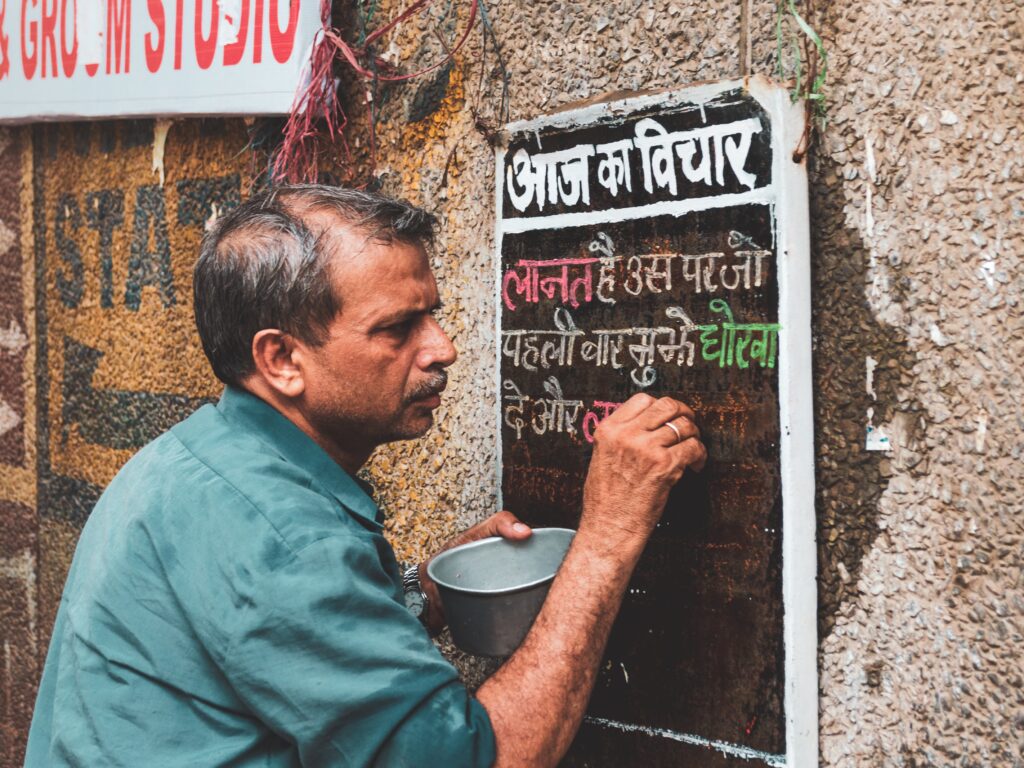Starting to learn a new language can be both fun and a bit tricky. We all know that it takes time and effort to become good at any language, including Hindi.
When learning Hindi, you have to keep a long-term mindset and be willing to practice day in and day out. It really is a matter of consistency and not giving up.
Once you’ve reached a certain level of learning Hindi, you’ll get access to a whole new culture of over 600 million people. You can use Hindi when traveling, speaking to people, or watching Bollywood movies. Besides that, you’ll be sure to impress some of your friends and family.
Many people wonder, “Is Hindi Hard to Learn?”
In this article, we’ll talk about the different parts of learning Hindi, what might be a bit tough, and how you can make it an enjoyable experience.
Whether you’re just curious about Hindi or thinking of giving it a try, let’s explore the journey together and find out how learning this language can be both interesting and doable.
Let’s get right into it.
Background of the Hindi Language

Hindi has a fascinating history that goes way back. It started with Sanskrit, an old language spoken more than two thousand years ago.
Over time, it mixed with other languages like Prakrit and Apabhramsa, especially during the medieval period when poets like Kabir contributed to its evolution.
The Mughal era added Persian influences, creating a unique blend. In the 19th century, Hindi took a more organized form thanks to language reformers and the adoption of the Devanagari script.
After India gained independence, Hindi became one of the official languages, playing a crucial role in bringing people together.
Today, Hindi is not just a language; it’s a reflection of India’s rich cultural history, blending the old with the new.
Why Is Hindi Hard to Learn?
Learning Hindi has some tough parts. One big challenge is the different way they write, called the Devanagari script. It has 46 characters that don’t look like the letters we use in English, so it takes some practice to get used to.
Another thing that can be hard is the sounds in Hindi—some are not like what we have in English. Also, Hindi sentences are built differently, with the subject coming first, which is different from English.
However, this doesn’t mean that you should give up learning Hindi. Although it comes with some challenges, the reward of learning the language of 600 million people is priceless.
Even though it might seem tough at first, staying positive, practicing regularly, and enjoying the culture can make learning Hindi a cool and interesting experience.
Let’s dive a bit deeper now.
How Long Does it Take to Learn Hindi Fluently?
When you’re diving into a new language like Hindi, you might wonder, “How long does it take to get really good at it?” Well, the answer isn’t one-size-fits-all. Let’s break it down in simpler terms.
1. Everyone’s Different:
People learn at different speeds. Your past experience with learning languages, how your brain works, and how much time you can spend practicing each day—all of these play a part.
2. Practice Makes Perfect:
The more you practice, the faster you’ll learn. If you make learning Hindi a regular part of your day and surround yourself with Hindi stuff (like movies or books), you’ll pick it up quicker.
3. Good Learning Tools Matter:
The tools you use matter too. Books, apps, online courses—pick what works for you. Also, talking to people who speak Hindi can be a game-changer. It’s like learning to ride a bike; the right tools and a bit of practice go a long way.
4. Hindi and English:
If you already speak English, some parts of Hindi might seem familiar, but others can be tricky. It’s like knowing some words but not understanding the whole story. Still, these similarities can help you learn faster.
5. Keep it Real:
Real talk—you won’t become a Hindi pro overnight. Learning takes time. You might get the basics in a few months, but becoming a Hindi master? That could take a few years. Celebrate the small wins, and don’t rush it.
In a nutshell, how fast you learn Hindi depends on you. Regular practice, using good tools, and staying patient are your best buddies on this journey.
Is Hindi Hard to Learn for English Speakers?
Learning a new language can be an adventure, and for English speakers delving into Hindi, the question arises: Is Hindi hard to learn for us? Let’s explore the similarities and difficulties that English speakers may encounter on this linguistic journey.
Similarities with English:
1. Shared Vocabulary:
Surprisingly, Hindi and English share some vocabulary thanks to historical connections. Words like “bazaar,” “jungle,” and “pyjamas” have common roots. This linguistic overlap provides a familiar starting point for English speakers, easing the initial steps into Hindi.
2. Numerical Similarities:
Both languages use the Indo-Arabic numeral system, making numbers familiar to English speakers. This common ground simplifies tasks such as counting, telling time, and expressing numerical information.
3. Pronunciation Crossovers:
While Hindi has unique sounds not found in English, there are also overlapping sounds that ease the transition. Some Hindi sounds, like “ka” and “na,” closely resemble their English counterparts, providing a bridge for pronunciation.
Difficulties to Consider when Learning Hindi:
1. Script Challenges:
The Devanagari script used in Hindi may be a stumbling block initially. English speakers are accustomed to the Latin alphabet, and mastering a new script requires practice. However, with consistent effort, learning Devanagari becomes a manageable challenge.
2. Grammatical Differences:
Hindi and English follow distinct grammatical structures. Hindi follows a subject-object-verb (SOV) sentence structure, while English uses subject-verb-object (SVO). Understanding and adapting to these grammatical nuances can pose a challenge, requiring a shift in language construction mindset.
3. Pronunciation Hurdles:
Certain Hindi sounds, such as retroflex consonants and nasal vowels, may be unfamiliar to English speakers. Achieving accurate pronunciation requires practice and exposure to native speakers or audio resources to grasp the subtleties of these unique sounds.
4. Linguistic Diversity:
Hindi is spoken in various dialects across India, leading to diversity in accents and expressions. This richness can be challenging for English speakers as they navigate through different linguistic variations. However, it also adds vibrancy to the language and offers a broader cultural understanding.
Is Hindi Hard to Learn: Key Features of the Hindi Language

Hindi, a language with a rich history and cultural significance, boasts distinctive features that contribute to its unique identity. Understanding these key features sheds light on the beauty and complexity of the Hindi language.
1. Devanagari Script:
At the heart of Hindi lies the Devanagari script, an ancient writing system with 46 characters. This script adds a visual and artistic dimension to the language, and each character has its own distinct sound. Learning Devanagari is an essential step for anyone delving into Hindi.
2. Pronunciation Variations:
Hindi encompasses a variety of sounds, some of which may be challenging for newcomers. Retroflex consonants and nasalized vowels add a distinctive flavor to Hindi pronunciation. While it may take practice, mastering these sounds enhances language proficiency.
3. Grammatical Structure:
Hindi follows a Subject-Object-Verb (SOV) sentence structure, a departure from the Subject-Verb-Object (SVO) structure in English. Understanding this grammatical nuance is crucial for constructing meaningful sentences in Hindi. The placement of subjects, objects, and verbs defines the flow of communication.
4. Gendered Nouns:
In Hindi, nouns are gendered, categorized as masculine or feminine. This gender aspect influences not only the nouns themselves but also their associated adjectives and verbs. This feature adds a layer of complexity for learners accustomed to languages without gendered nouns.
5. Verb Conjugation:
Hindi employs verb conjugation to indicate tense, aspect, mood, and the gender and number of the subject. Verbs undergo changes based on these factors, offering a nuanced way to express actions and events. This feature contributes to the expressive and context-rich nature of the language.
6. Honorifics and Politeness:
Hindi places significant importance on politeness and respect. The use of honorifics, such as “ji” or “saa,” conveys a sense of respect when addressing others. Understanding and employing these honorifics appropriately is integral to effective communication in Hindi.
7. Dialectical Diversity:
Hindi is spoken in various dialects across different regions of India. Each dialect adds its own flavor to the language, introducing unique vocabulary, accents, and expressions. Embracing this diversity provides learners with a more comprehensive understanding of Hindi language and culture.
Is It Worth It to Learn the Hindi Language?
Yes, definitely. Learning Hindi goes beyond making travel and work easier—it’s a ticket to understanding the rich culture of India.
It lets you connect with over 600 million people globally and adds a unique layer to your communication skills.
Whether you’re exploring India’s diverse landscapes, seeking career opportunities, or just delving into Hindi literature, the benefits of learning Hindi extend far beyond the language itself, making it a rewarding and worthwhile endeavor.
Learning Hindi may be a bit of a challenge, but the rewards are well worth it.
What Is The Best Way to Learn Hindi?

Starting your journey to learn Hindi involves choosing the right tools and resources. Let’s explore a variety of options, including language apps, online courses, podcasts, books, and conversational practice platforms, to help you navigate the diverse landscape of Hindi language learning.
1. Language Apps:
Language apps have revolutionized language learning, and Hindi is no exception. Apps like Duolingo, Babbel, and Rosetta Stone (see my best learning apps article) offer interactive lessons, vocabulary-building exercises, and progress tracking. These user-friendly platforms make learning on the go convenient, allowing learners to practice Hindi whenever and wherever they choose.
2. Online Courses:
Comprehensive online courses provide structured learning experiences for mastering Hindi. Platforms like Udemy, Coursera, and HindiPod101 offer courses ranging from beginner to advanced levels. These courses often include video lessons, quizzes, and assignments, providing a systematic approach to language acquisition.
3. Podcasts:
Podcasts offer an excellent way to improve listening skills and familiarize yourself with authentic Hindi conversations. Podcasts like “Learn Hindi with Niharika” and “Hindi Unplugged” cater to learners of various proficiency levels. Listening to native speakers helps refine pronunciation and comprehension in a more casual setting.
4. Books:
Traditional learning through books remains a valuable resource for learning Hindi. Textbooks like “Teach Yourself Hindi” or “Complete Hindi” offer structured lessons, grammar explanations, and exercises. Supplementary materials such as bilingual dictionaries and phrasebooks provide additional support.
5. Conversational Practice Platforms:
Engaging in conversations with native speakers is crucial for language proficiency. Platforms like Tandem, HelloTalk, and iTalki connect language learners with native Hindi speakers for real-time conversations. These exchanges offer cultural insights, improve spoken fluency, and provide valuable feedback.
My 5 Tips to Make Learning Hindi Easy and Fun

Learning Hindi should be fun, and I’ve got five easy tips to make it enjoyable:
1. Play with Language Apps:
Try out apps like Duolingo and Drops. They turn learning into games with challenges and rewards. It’s like playing and learning at the same time!
2. Enjoy Bollywood and Music:
Watch Bollywood movies, listen to Hindi songs, and enjoy popular TV shows. It’s a fun way to pick up the language and learn about Indian culture.
3. Make Learning a Game:
Turn learning into a game by setting goals and rewarding yourself. Challenge yourself to learn a few new words or complete a lesson in a certain time. When you achieve your goals, treat yourself to something nice!
4. Chat with Hindi Speakers:
Connect with Hindi speakers on platforms like Tandem or HelloTalk. Talking with real people not only improves your Hindi but also makes learning social and fun.
5. Build a Learning Routine:
Create a routine for learning Hindi. Set specific times for practice, like using an app in the morning, watching a movie in the afternoon, or chatting with a language exchange partner in the evening. Having a routine makes learning easy and part of your everyday life.
In a nutshell, learning Hindi can be easy and enjoyable. Use apps, enjoy Bollywood, make it a game, chat with people, and build a routine.
Soon, you’ll find yourself having fun while picking up a new language!
Wrap Up: Is Hindi Hard to Learn?
In the journey of exploring the question, “Is Hindi Hard to Learn?” we’ve talked about the unique challenges that learners might face.
It does have some tricky parts, like the different way they write and the sounds that might be new. Sentences are built differently too. But, don’t let that stop you!
Learning Hindi is like an exciting journey full of new things to discover. Even if it feels tough at the start, staying positive, practicing regularly, and enjoying the cool things about Hindi can turn the challenge into something fun and interesting.
Think of it as an adventure, where each step brings you closer to understanding the language and the awesome culture it comes from.
So, go ahead, embrace the journey, and enjoy the richness of learning Hindi!
Frequently Asked Questions (FAQ)
1. Is Hindi hard to learn for English speakers to learn?
Learning any new language has its challenges, and Hindi is no exception. Differences in script, pronunciation, and grammar may make it seem challenging initially, but with dedication and practice, it becomes more manageable.
2. How long does it take to learn Hindi fluently?
The time to achieve fluency varies for each person. Factors like prior language learning experience, study intensity, and exposure to the language all play a role. Generally, achieving basic proficiency might take a few months, while full fluency could take several years.
3. What’s the best way to learn Hindi?
The best way to learn Hindi depends on individual preferences. Language apps, online courses, podcasts, books, and conversational practice platforms all offer valuable resources. Combining these methods to suit your learning style often yields the most effective results.
4. Why is the Devanagari script challenging?
The Devanagari script used in Hindi is different from the Latin alphabet. It has 46 characters, and getting used to these new symbols may be challenging initially. However, consistent practice and exposure can help learners become comfortable with the script.
5. How can I make learning Hindi more enjoyable?
Making learning enjoyable involves incorporating interactive apps, immersing yourself in Hindi pop culture like movies and music, gamifying your learning with goals and rewards, engaging in language exchange for real conversations, and establishing a consistent learning routine.
6. Is it worth learning Hindi for travel or work?
Yes, learning Hindi can be highly beneficial for travel and work. It enhances travel experiences in Hindi-speaking regions, provides cultural insights, and may open up professional opportunities in diverse fields, given the global significance of the language.
7. Can I learn Hindi without formal classes?
Absolutely! Many learners successfully acquire Hindi proficiency through self-study using online resources, language apps, and immersive experiences. The key is to find a method that suits your learning style and stay consistent in your practice.
Related: Is Spanish Hard to Learn? Is Vietnamese Hard to Learn?

